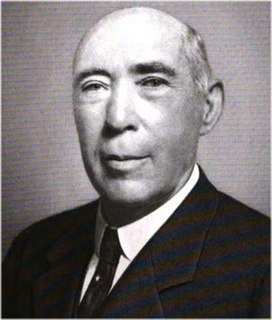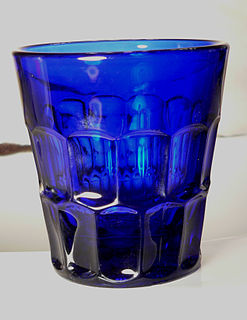
Bellaire is a village in Belmont County, Ohio, United States. It is part of the Wheeling, West Virginia Metropolitan Statistical Area, and Wheeling is across the Ohio to the east. The population was 4,278 at the 2010 census, having had its peak in 1920. The city is located along the Ohio River.

Uranium glass is glass which has had uranium, usually in oxide diuranate form, added to a glass mix before melting for colouration. The proportion usually varies from trace levels to about 2% uranium by weight, although some 20th-century pieces were made with up to 25% uranium.

Depression glass is glassware made in the period 1929–1939, often clear or colored translucent machine-made glassware that was distributed free, or at low cost, in the United States and Canada around the time of the Great Depression. Depression glass is so called because collectors generally associate mass-produced glassware in pink, yellow, crystal, and green with the Great Depression in America.
Bakewell Glass is nineteenth-century glassware from Pittsburgh, Pennsylvania, produced by a company founded by Benjamin Bakewell. Bakewell's company can be found under the names ThePittsburgh Glass Manufactory, Bakewell & Page and, Bakewell, Pears & Co. Bakewell glass built a reputation of being both luxurious and utilitarian during the 80 years it was in business.

Blenko Glass Company, located in Milton, West Virginia, is known for its artistic hand-blown glass.

Anchor Hocking Company is a manufacturer of glassware. The Hocking Glass Company was founded in 1905 by Isaac Jacob (Ike) Collins in Lancaster, Ohio, and named after the Hocking River.
The firm of James Powell and Sons, also known as Whitefriars Glass, were London-based English glassmakers, leadlighters and stained glass window manufacturers. As Whitefriars Glass, the company existed from the 17th century, but became well known as a result of the 19th-century Gothic Revival and the demand for stained glass windows.

The Fenton Art Glass Company is a glass manufacturer founded in 1905 by brothers Frank L. Fenton and John W. Fenton.

Henry Clay Fry was an American businessman and entrepreneur in the glass industry in the second half of the nineteenth century and first half of the twentieth century. He first organized a large glass manufacturing facility with others that made glass tumbler beverage containers that were sold worldwide. In 1901 he organized with his sons H. C. Fry Glass, a glass manufacturer that had state-of-the-art techniques and made all kinds of glass. In 1916 under an agreement with Corning Glass Works he made heat-resistant glassware. The glass now is a collector's item of historical significance and there is a H. C. Fry Glass Society for the study and preservation of his glass.
The Fostoria Glass Company was a manufacturer of pressed, blown and hand-molded glassware and tableware. It began operations in Fostoria, Ohio, on December 15, 1887, on land donated by the townspeople. The new company was formed by men from West Virginia who were experienced in the glassmaking business. They started their company in northwest Ohio to take advantage of newly discovered natural gas that was an ideal fuel for glassmaking. Numerous other businesses were also started in the area, and collectively they depleted the natural gas supply. Fuel shortages caused the company to move to Moundsville, West Virginia in 1891.

Ralph Mallory Kovel was an American author of 97 books and guides to antiques, co-authored with his wife, Terry Kovel. They wrote a nationally syndicated collectibles column that began in 1955.
The Macbeth-Evans Glass Company was an American glass company that created "almost every kind of glass for illuminating, industrial and scientific purposes," but is today famous for making depression glass.

Elegant glass is high quality glassware created in the United States during the Depression Era. It was sold for high prices in department stores and given as wedding gifts. When new, Elegant glass would cost more than its oft-confused counterpart, Depression glass, because it was at least partially handmade, had a cleaner finish, and more vibrant colors. From the 1920s through the 1950s, Elegant glass was an alternative to fine china. Most of the Elegant glassware manufacturers closed by the end of the 1950s, and cheap glassware and imported china took its place.

The Hostmaster Pattern was manufactured by New Martinsville Glass Company during the 1930s. Though the line was extensive, New Martinsville Hostmaster Pattern is one of the lesser known patterns of Elegant Glass. There are no reproductions as the mold was melted down to make the Raindrops pattern.
J. H. Hobbs, Brockunier and Company was one of the largest and best known manufacturers of glass in the United States in the 19th century. Its products were distributed world-wide. The company is responsible for one of the greatest innovations in American glassmaking—an improved formula for lime glass that enabled American glass makers to produce high-quality glass at a lower cost. The firm also developed many of the talented glassmakers that started glass factories in Ohio and Indiana.

The Northwood glass company was a manufacturer of art glass in various locations in the United States from 1887 to 1925.

Peking glass is a form of Chinese glassware that originated in 18th century Peking, China. Originally used in the fabrication of glass snuff bottles, Peking glass has since been appropriated for a number of uses and continues to be produced in China.
Indiana Glass Company was an American company that manufactured pressed, blown and hand-molded glassware and tableware for almost 100 years. Predecessors to the company began operations in Dunkirk, Indiana, in 1896 and 1904, when East Central Indiana experienced the Indiana gas boom. The company started in 1907, when a group of investors led by Frank W. Merry formed a company to buy the Dunkirk glass plant that belonged to the bankrupt National Glass Company. National Glass was a trust for glass tableware that originally owned 19 glass factories including the plant in Dunkirk. National Glass went bankrupt in 1907, and its assets were sold in late 1908.
The Lancaster Glass Company was a producer of manufactured glassware in Lancaster, Ohio that ran from 1908 to 1937. They are a producer of depression glass and were known as an early innovator of color in depression-era glassware.
















